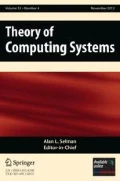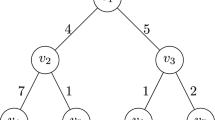Abstract
In this paper we present a general strategy for finding efficient permutation routes in parallel networks. Among the popular parallel networks to which the strategy applies are mesh networks, hypercube networks, hypercube-derivative networks, ring networks, and star networks. The routes produced are generally congestion-free and take a number of routing steps that is within a small constant factor of the diameter of the network. Our basic strategy is derived from an algorithm that finds (in polynomial time) efficient permutation routes for aproduct network, G×H, given efficient permutation routes forG andH. We investigate the use of this algorithm for routingmultiple permutations and extend its applicability to a wide class of graphs, including several families ofCayley graphs. Finally, we show that our approach can be used to find efficient permutation routes among the remaining live nodes infaulty networks.
Similar content being viewed by others
References
G. B. Adams III and H. J. Siegel (1982): The extra-stage cube: A fault-tolerant interconnection network for supersystems.IEEE Transactions on Computers, Vol. 31, No. 5, pp. 443–454.
B. Aiello, T. Leighton, B. Maggs, and M. Newman (1990): Fast algorithms for bit-serial routing on a hypercube.Proceedings of the 2nd Symposium on Parallel Algorithms and Architectures, pp. 55–64.
S. B. Akers and B. Krishnamurthy (1989): A group-theoretic model for symmetric interconnection networks.IEEE Transactions on Computers, Vol. 38, No. 4, pp. 555–566.
G. S. Almasi and A. Gottlieb (1989):Highly Parallel Computing. Benjamin/Cummings, Redwood City, CA.
B. Alspach and T. D. Parsons (1982): A construction for vertex-transitive graphs.Canadian Journal of Mathematics, Vol. 34, No. 2, pp. 307–318.
F. Annexstein (1989): Fault tolerance of hypercube-derivative networks.Proceedings of the 1st Symposium on Parallel Algorithms and Architectures, pp. 179–188.
F. Annexstein, M. Baumslag, and A. L. Rosenberg (1990): Group action graphs and parallel architectures.Siam Journal on Computing, Vol. 19, No. 3, pp. 544–569.
V. E. Beneš (1965):Mathematical Theory of Connecting Networks. Mathematics in Science and Engineering, Vol. 17. Academic Press, New York.
J.-C. Bermond, C. Delorme, and J.-J. Quisquater (1986): Strategies for interconnection networks: Some methods from graph theory.Journal of Parallel and Distributed Computing, Vol. 3, pp. 433–449.
K. D. Blaha (1989): Algorithms for permutation groups and Cayley networks. Doctoral thesis, University of Oregon, Eugene.
B. Bollobas (1978):Extremal Graph Theory. Academic Press, New York.
L. Campbell, G. E. Carlsson, V. Faber, M. R. Fellows, M. A. Langston, J. W. Moore, A. P. Mullhaupt, and H. B. Sexton (1988): Dense symmetric networks from linear groups and codes. Computer Science Technical Report CS-88-192, Washington State University.
G. E. Carlsson, J. E. Cruthirds, H. B. Sexton, and C. G. Wright (1985): Interconnection networks based on a generalization of the cube-connected cycles.IEEE Transactions on Computers, Vol. 34, No. 8, pp. 769–772.
C. Clos (1959): A study of non-blocking switching networks.Bell System Technical Journal, Vol. 32, pp. 406–424.
W. J. Dally and C. L. Seitz (1987): Deadlock-free message routing in multiprocessor interconnection networks.IEEE Transactions on Computers, Vol. 36, No. 5, pp. 547–553.
M. R. Fellows (1985): Encoding graphs in graphs. Doctoral thesis, University of California, San Diego.
W. H. Gates and C. H. Papadimitriou (1979): Bounds for sorting by prefix reversal.Discrete Mathematics, Vol. 27, pp. 47–57.
D. Greenberg (1990): Private communication.
D. Greenberg and S. Bhatt (1990): Routing multiple paths in hypercubes.Proceedings of the 2nd Symposium on Parallel Algorithms and Architectures, pp. 45–54.
M. Herbordt, C. Weems, and J. Corbett (1990): Message-passing algorithms for a SIMD torus with coteries.Proceedings of the 2nd Symposium on Parallel Algorithms and Architectures, pp. 11–21.
D. Krizanc, S. Rajasekaran, and T. Tsantilas (1988): Optimal routing algorithms for mesh-connected processor arrays. InVLSI Algorithms and Architectures (J. H. Reif, ed.). (Proceedings of the 3rd AWOC 88.) Lecture Notes in Computer Science, Vol. 319. Springer-Verlag, Berlin, pp. 411–422.
M. Kunde (1988): Routing and sorting on mesh-connected arrays. InVLSI Algorithms and Architectures (J. H. Reif, ed.). (Proceedings of the 3rd AWOC 88). Lecture Notes in Computer Science, Vol. 319. Springer-Verlag, Berlin, pp. 423–433.
A. Lubotzky, R. Philips, and P. Sarnak (1988): Ramanujan graphs.Combinatorica, Vol. 8, pp. 261–277.
K. Mulmuley, U. V. Vazarani, and V. V. Vazarani (1987): Matching is as easy as matrix inversion.Proceedings of the 19th Annual Symposium on Theory of Computing, pp. 345–354.
D. Nassimi and S. Sahni (1980): An optimal routing algorithm for mesh-connected parallel computers.Journal of the Association for Computing Machinery, Vol. 27, No. 1, pp. 6–29.
D. Nassimi and S. Sahni (1982): Parallel algorithms to set up the Beneš permutation network.IEEE Transactions on Computers, Vol. 31, No. 2, pp. 148–154.
M. A. Palis, S. Rajasekaran and D. S. L. Wei (1990): General routing algorithms for star graphs.Proceedings of the Fourth Annual Parallel Processing Systems Symposium.
C. Papadimitriou and K. Steiglitz (1982):Combinatorial Optimization. Prentice-Hall, Englewood Cliffs, NJ.
D. S. Parker (1980): Notes on shuffle/exchange-type switching networks.IEEE Transactions on Computers, Vol. 29, No. 3, pp. 213–222.
D. S. Parker and C. S. Raghavendra (1984): The Gamma network.IEEE Transactions on Computers, Vol. 33, No. 4, pp. 367–373.
F. P. Preparata and J. E. Vuillemin (1981): The cube-connected cycles: a versatile network for parallel computation.Communications of the ACM, Vol. 24, pp. 300–309.
A. Ranade (1987): How to emulate shared memory.Proceedings of the 28th Symposium on Foundations of Computer Science, pp. 496–504.
D. J. S. Robinson (1980):A Course in the Theory of Groups. Springer-Verlag, Berlin.
A. L. Rosenberg (1988): The product-shuffle network: toward reconciling shuffles and butterflies.Journal of Discrete Applied Mathematics, to appear.
Y. Saad and M. H. Schultz (1989): Data communication in hypercubes.Journal of Parallel and Distributed Computing, Vol. 6, pp. 115–135.
D. Slepian (1952): Two theorems on a particular crossbar switching network. Unpublished manuscript.
D. Tzvieli (1988): Minimal diameter double-ring networks, I: some very large infinite optimal families. Typescript, Louisiana State University.
J. D. Ullman (1983):Computational Aspects of VLSI. Computer Science Press, Rockville, MD.
L. G. Valiant and G. J. Brebner (1981): Universal schemes for parallel communication.Proceedings of the 13th Symposium on Theory of Computation, pp. 263–277.
Author information
Authors and Affiliations
Additional information
This research was supported in part by a grant from the NSF, Grant No. CCR-88-12567.
Rights and permissions
About this article
Cite this article
Baumslag, M., Annexstein, F. A unified framework for off-line permutation routing in parallel networks. Math. Systems Theory 24, 233–251 (1991). https://doi.org/10.1007/BF02090401
Received:
Revised:
Issue Date:
DOI: https://doi.org/10.1007/BF02090401




